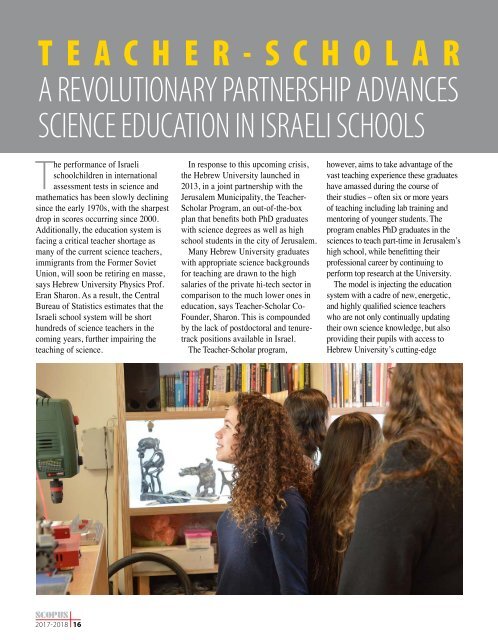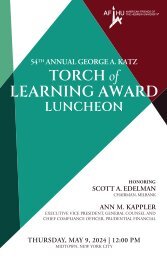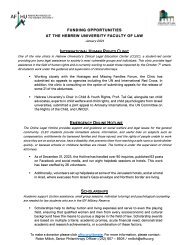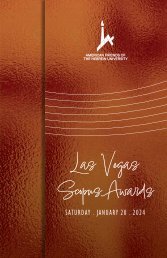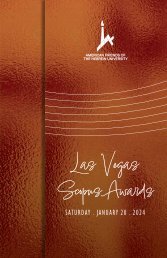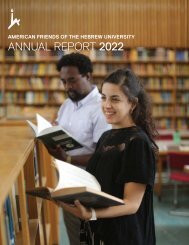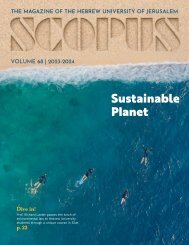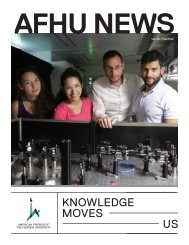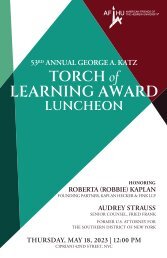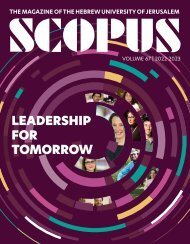You also want an ePaper? Increase the reach of your titles
YUMPU automatically turns print PDFs into web optimized ePapers that Google loves.
educing the side effects of<br />
cancer medicines, Benny says<br />
while adding to her sketch a row of<br />
arrows penetrating and attacking the<br />
tumor.<br />
“Our approach differs from<br />
basic biology,” she says. “We use<br />
engineering models.”<br />
Tumor-on-a-Chip<br />
Along these same lines, Benny’s<br />
lab has incredibly developed a model<br />
in which they use cell samples from<br />
patients with cancer to replicate their<br />
cancerous tumors outside the body on<br />
coin-sized chips. These chips allow<br />
scientists to understand the vascular<br />
make-up of the individual tumor and<br />
select the best<br />
nanoparticle to<br />
use for effective drug<br />
delivery—with the aim<br />
that medicines which work<br />
on the chip in a lab will also<br />
be effective for the patient.<br />
“It’s personalized nanomedicine.”<br />
says Benny. “Controlling and treating<br />
tumors this way is similar to the way<br />
medicine approaches other treatable<br />
conditions like arthritis and asthma.”<br />
Benny’s research comes on the<br />
heels of the highly successful “liveron-a-chip”<br />
technology developed by<br />
one of the global leaders in human<br />
chip development. Hebrew University<br />
bioengineer Prof. Yaakov Nahmias is<br />
growing living liver tissue, complete<br />
with the liver’s complex system of<br />
blood vessels on a coin-sized chip,<br />
to test the safety of medications<br />
more accurately, a process that drug<br />
companies often spend years and<br />
millions of dollars to complete.<br />
Nahmias and his team at the Alexander<br />
Grass Center for Bioengineering,<br />
which he founded and runs, integrate<br />
tiny censors—no larger than the width<br />
of a strand of hair—into the chip to<br />
measure levels of oxygen and other<br />
indicators that measure the toxicity of<br />
drugs.<br />
The chip mimics human physiology<br />
which lets pharmaceutical developers<br />
see in real time how their drugs<br />
affect liver function, rather than<br />
having to perform arduous tests on<br />
animal and human subjects. “This<br />
is a transformative technology,”<br />
says Nahmias, whose lab has raised<br />
millions of dollars, and recently<br />
launched the biotechnology<br />
company, Tissue Dynamics, which<br />
has in place commercial agreements<br />
with pharmaceutical and cosmetic<br />
companies<br />
already benefiting from the<br />
revolutionary technology.<br />
Beyond Our Wildest<br />
Imagination<br />
Diamonds have long captivated<br />
humankind. They have been the<br />
catalyst for wars and been worn on the<br />
fingers of royalty for centuries, but for<br />
Assistant Professor of Applied Physics<br />
Nir Bar-Gill, these jewels can replicate<br />
magnetic resonance imaging (MRI).<br />
Bar-Gill is actually interested in the<br />
small defects in diamonds—what<br />
might appear as a pinkish hue to the<br />
naked eye—but are known as nitrogenvacancy<br />
centers to physicists. In what<br />
defies our imaginations, Bar-Gill,<br />
who is also a member of the Racah<br />
Institute of Physics, is using those tiny<br />
defects to develop a handheld medicalimaging<br />
device that produces images<br />
with a much higher resolution than our<br />
current full body MRI machines—and<br />
at a fraction of the cost.<br />
These “defects” act as isolated<br />
quantum systems, meaning they can<br />
respond to the natural magnetic forces<br />
in the body and help create high-quality<br />
optical images, Bar-Gill explains. The<br />
lab model of this system looks like a<br />
jumble of camera parts and wires to<br />
the untrained eye, but Bar-Gill predicts<br />
it could be a working hand held MRI<br />
within the next five years.<br />
<strong>2017</strong>-2018 9


